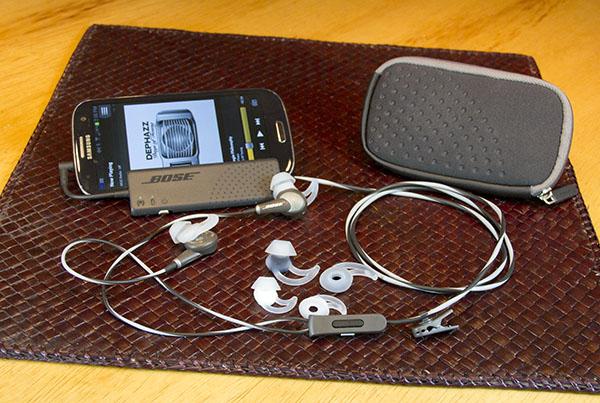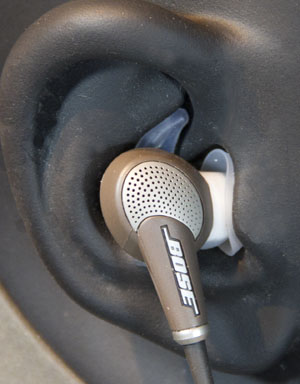| Columns Retired Columns & Blogs |
A Traveler's Sanctuary: The Bose Quiet Comfort 20 Noise Canceling Earphone

This story originally appeared at InnerFidelity.com
I don't like noise canceling headphones.
I have a deep dislike for noise canceling headphones. Generally they sound bad, and many don't cancel noise very well. But "Noise Canceling" has become a big buzzword, so much so that many people want it without even knowing what it is (I explain it here), which just drives the market up for crappy noise cancelers. I hate it when stuff like that happens.
Bose can take the blame—and the credit—for that. They marketed the heck out of noise canceling and sold the public on the idea. Bose and noise canceling are pretty close to synonymous for consumers. The problem I have with it all is that most people just don't need noise canceling headphones in the first place. In-ear and traditional around-ear sealed headphone are fine for most people most of the time...but they know the buzzword, so they think they need one. Ergh.
On the other hand, when you do need a noise canceling headphone (mainly on planes and trains, and when you don't want to use in-ear headphones), Bose does seem to do it better than everyone else...well, the noise canceling anyway. And it is the noise canceling bit that's important in these cases. In very loud environments, audiophile-quality reproduction really isn't appreciable with all the background noise, even if you can reduce it significantly. Given the state-of-the-art today, if you can get >20dB isolation and decent mid-fi quality sound from a noise canceler, you're doing well...and in my view, Bose is the only one managing to pull it off at all. The Bose Quiet Comfort 15 faired best in my review of noise canceling headphones last year, and nothing has come through my hands to change that opinion, until...
Bose QuietComfort 20 Noise Canceling Earphones ($299)
Every time I put the QC20 in my ears, I can't help but think a whole heck of a lot of R&D went into these earphones; they do things that I didn't think could be done. Let me start from the beginning.
The Bose QuietComfort 20 is an in-ear, active noise canceling earphone. Calling them an "in-ear" earphone is a bit of a misnomer as they don't actually seal inside the ear canal, but rather rest against the opening---sort of like your finger tips when plugging your ears, but softer and with lighter pressure. If you've spent any time with a normal in-ear headphone you'll know that getting a good seal is critical to getting good bass response. I'll be damned if I know how Bose got the QC20 to have any bass response at all as they simply don't seem to seal well enough, but they did...more on this later.
Earpieces are separately wired and join the main cable at the remote control. Two versions of the QC20 are available: one has an three-button Apple compatible remote (QC20i); the other has a single-button Android/Backberry/Windows smartphone remote (QC20). Both remotes include a button to engage the "Aware Mode", which significantly reduces the noise canceling and opens a microphone to let you hear outside sounds. Between the remote and control module is a 33"long, gray and black, barber-shop-pole-stripped cable, 0.1" (2.6mm) in diameter. I mention the size of this cable as it's a tad larger than similar cables on IEMs, but it's pretty compact considering how many conductors must be inside. I'm speculating a bit here, but I reckon each ear-piece has two microphones (one external and one in the bore of the earpiece) and one driver, and the Apple remote has a mic, three player control buttons, and the Aware mode button. Assuming they all share a common ground, that's a total of 11 signal carrying conductors and at least one ground; so the cable from the remote to the control module is at least 12 conductors. I'd say the cable is pretty svelte and flexible given the duties it's performing.
The control module is a fairly small, light unit measuring 3.5"x1.25"x0.28", which contains all the electronics and lithium-ion battery. The battery is not replaceable; Bose claims it should retain its original capacity for 500 charge cycles and will operate for some time with reduced capacity thereafter. The control module includes: a switch to turn on the noise canceling electronics; LEDs to indicate charging, noise canceling, and Aware Mode operation; a Micro B USB jack for charging; and a 2" pig-tail input cable terminated in a 90 degree angle, 3.5mm, TRRS plug.
Also included with the Bose QuietComfort 20 are: small, medium, and large StayHear+ tips; a shirt clip; a short USB charging cable; and a small (5"x2.75") padded carry pouch.
Comfort and Ergonomics
 The Bose QuietComfort 20 "StayHear+" ear-tips are spectacularly comfortable and were very easy for me to wear for extended periods of time while traveling. They gently rest up against the entrance to your ear canal, and the "wings" slip into the upper part of the bowl of your ear (cymba concha) for a secure fit. These ear-tips have a unique mating with the ear-piece, sliding over a nozzle and clicking into a small barbed detent to secure the tip onto the housing. Comply and other after market tips will not fit on the QC20. The fit and comfort of these tips in my ears gets an A+ from me; Bose engineers did a great job with this critical physical interface.
The Bose QuietComfort 20 "StayHear+" ear-tips are spectacularly comfortable and were very easy for me to wear for extended periods of time while traveling. They gently rest up against the entrance to your ear canal, and the "wings" slip into the upper part of the bowl of your ear (cymba concha) for a secure fit. These ear-tips have a unique mating with the ear-piece, sliding over a nozzle and clicking into a small barbed detent to secure the tip onto the housing. Comply and other after market tips will not fit on the QC20. The fit and comfort of these tips in my ears gets an A+ from me; Bose engineers did a great job with this critical physical interface.
I reviewed the one-button Android remote version of the QC20 and found the remote well positioned on the cable, and reaching and actuating controls was convenient and comfortable.
The control module at the end of the cable was a bit troublesome...though I think, given he amount of electronic circuitry and battery it contains, it's a very reasonable solution to the problem—it's got to go somewhere. I simply let it dangle for a while as I first started to use the QC20 and it wasn't too terribly bothersome. Eventually I rummaged through a drawer to find some 3M Command Strips (3M# 17201BLK, available at most stationary and hardware stores) and attached the control module to the back of my Otterbox Defender case wrapped Galaxy S3 phone. This worked reasonable well and I could still easily slip it into my pocket. However, the cable did get in the way of the camera sensors; I ended up positioning the cable between the lens and flash LED, which did create a shadow with flash photos—I never use my phone in that way, but others no doubt will.
With the control module in the palm of my hand, I wrap the cable around my four fingers until reaching the ear-pieces and then slip it into it's case when it's time to tuck it away. I found the included case very convenient and easy to carry in a shirt pocked or briefcase.
Now, let's get on to the important bits, isolation and sound quality...
- Log in or register to post comments




































